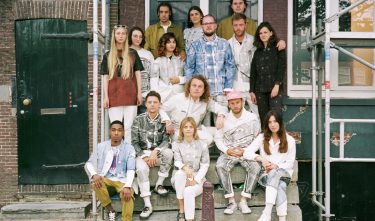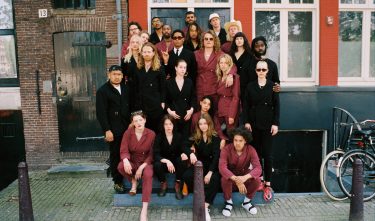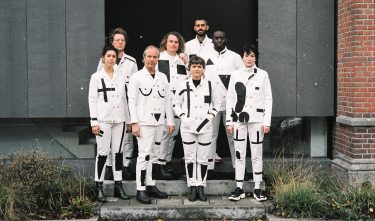Who are the winners of Dutch Design Awards? What drives them and what is their vision of design? This time in the Winner’s Portrait series is Bonne Reijn. He won a Dutch Design Award in the category Fashion with his De Rrusie Suit, designed in collaboration with Kevin ‘De Rrusie’ Lucas.
 1
1
Why do you call your creations ‘poor man’s suits’?
‘A Bonne Suit consists of a pair of trousers and a jacket with a simple design, long-lasting quality and a good price. Everyone can wear it. On one hand it is a celebration of simplicity and on the other hand a protest against the current fashion industry, where luxury brand names seem to be more important than personal style. Wouldn’t it be great if everyone received a Bonne Suit from the Tax Office? It would be sustainable and do away with all the hassle surrounding fashion.’
— 'With my clothing, I want to take things back to zero. Stripped of all the bravado that so often surrounds fashion today.' - Bonne
What bothers you most about the current fashion landscape?
‘I think that the art form of fashion has less and less freedom. Fashion has become a polluting, disposable product, while it is essentially such fun. The art of clothing and of making clothing is something we have been doing since time immemorial. People want to express themselves through clothing and look their very best for each other. This fascinates me. With my clothing, I want to take things back to zero. Stripped of all the bravado that so often surrounds fashion today.’
Of course, you are now also part of that same industry. How do you deal with it?
‘As honestly and genuinely as possible. This starts with our product. It is timeless in design and high in quality, which means that our suits can be worn for a long time. Our communication campaign is also devoid of glamour. We always use the same image: our own friends wearing a Bonne Suit. Just on the pavement in front of my house in Amsterdam. Furthermore, we only produce ‘on demand’. So we never run the risk of being stuck with large volumes of stock.’
 2
2
 3
3
How do you think the fashion industry is going to develop?
‘Through my own approach, I have become connected with a certain youth culture. A group of people who feel the same dissatisfaction as me and feel the same need for honest brands and communication. They see through fake. I think this group will continue to grow and that the demand for unique pieces and tailoring will increase. Many young designers leave the academy and do not want to participate in the mass production of fashion, so they get to work themselves. Ironically enough, this can work through another great power: social media. Via Instagram I can see where I need to go in New York for a really well-tailored denim suit. The internet offers freedom and international opportunities for smaller designers and entrepreneurs.’
People who wear your suits clearly like to experiment with their identity, but it is also a uniform. Why do you think this is?
‘Style is not what you’re wearing but is all about your personality. How you carry yourself, how you treat people, the way you speak and think. Clothing is an instrument for showing all this. You can express yourself much more with a Bonne Suit. Precisely because it is so uniform. It better communicates your personality, or you can add a little something extra. It really focusses on the person wearing the suit and not on the large logo on an overpriced t-shirt. If I look at our international reach, I see such a varied group of people wearing our clothing. From hip-hop guys to students and older people. That’s exactly the intention. I want to dress everyone.’
Isn’t it scary, focusing on just one item?
‘Building up your own brand without investors is scary in itself. And fashion is a strange world where you constantly feel like you are playing catch-up. Do people still like it? Is it still selling? Does it still fit with what people want to wear? These are questions you always ask yourself. But put us next to a fashion designer who has to punch out a new collection every season, and thereby rediscover themselves every time. I think that would be just as stressful as making just one item. I have noticed that focusing on a small collection means that we can connect with people in a sustainable way.’
What are your plans for the future?
‘Bonne Suits can gradually develop. Unisex remains our starting point and the Bonne Suit is paramount. With a cool collaboration or a tweak here and there, like shorts or a boiler suit in order to meet our customers’ wishes. We have just opened a shop in Amsterdam and are hungry for more. My suits are already sold in New York, L.A. and in various places in Japan. But I’m also thinking about shops in London and Paris.’
Bonne Suits
With a minimalistic design, a low price and a wide range of sizes, Bonne Suits are available to a large audience. Regardless of sex, age, sub-culture or class. With his self-named ‘poor man’s suits’ Bonne Reijn wants to challenge and change the expectations people have of their clothing – and suits in particular. And also to increase and accentuate the attention for personal style in fashion. The winning De Rrusie Suit is Bonne Reijn’s second design.